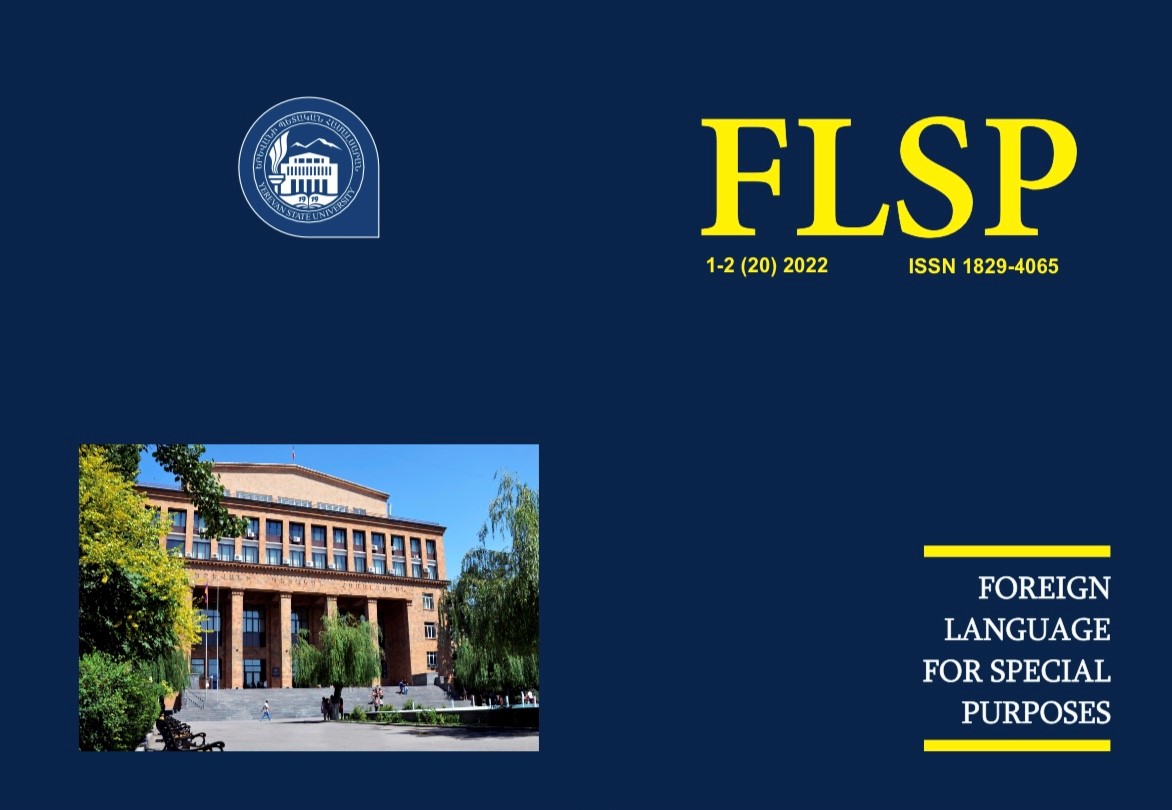STRATEGIES FOR TEACHING ENGLISH SOCIO-CULTURAL LACUNAE
DOI:
https://doi.org/10.46991/flsp.v20i1-2.8954Keywords:
lacuna, realia, elimination, cognitive strategy, metacognitive strategy, affective strategy, compensatory strategy, social strategyAbstract
At the present stage, there are various typologies of lacunaes: linguistic, cultural, textual, behavioral, etc. The strategy for eliminating lacunaes should be used in high school, first of all, to understand lacunaes. It is inappropriate to set the task of recreating the cultural coloring of the text through the translation of lacunaes. Well-chosen interpretations and comments can help students eliminate the lacunaes in the text. It is important to note that preference should be given to research interpretations, as they help to identify national features of perception of facts. Given the fact that lacunaes are eliminated by filling and compensation, compensatory strategies should be preferred. The use of effective and social strategies is an important condition for the rapid assimilation and proper reproduction of lacunaes. In some cases, it is necessary to present lacunaes not only with comments, but also with texts. When learning lacunaes, you can use the possibilities of positive transfer. At the level of understanding the lacunaes, it is desirable to memorize the English or international lacunaes that are already in circulation in the Armenian language. The use of metacognitive strategies can only be effective among advanced level students.
References
Antipov G. A., Donskih O. A., Markovina I. Ju., Sorokin Ju. A. Tekst kak javlenie kul'tury. Novosibirsk: Nauka, 1989. - 197 s.
Bykova G.V. Lakunarnost' kak kategorija leksicheskoj sistemologii. Blagoveshhensk.: Izd-vo BGPU, 2003. 364s.
Kretov A. A. K tipologii realij i lakun / A. A. Kretov, N. A. Fenenko // Sociokul'turnye problemy perevoda : sb. nauch. tr. - Voronezh, 2012. - Vyp. 10. - S. 39-45.
Murav'ev V.L. Problemy vozniknovenija jetnograficheskih lakun. Vladimir, 1980. 104s․
Popova Z.D. Kognitivnaja lingvistika / Z.D. Popova, I.A. Sternin. M.: ACT: Vostok-Zapad, 2007. 314s.
Skugarova, Ju.V. Problema ponimanija inojazychnogo literaturno-hudozhestvennogo teksta: Filol. i didakt. aspekt (na materiale angl. rasskazov XX v.): Avtoref. dis… kand. filol. nauk [Tekst]/ Ju.V. Skugarova. – M.: MGU im. M.V. Lomonosova. – M., 2001.
Sorokin Ju.A. Lakuny: eshhe odin rakurs rassmotrenija // Lakuny v jazyke i rechi: sb. nauch. trudov / pod red. prof. Ju.A. Sorokina, prof. G.V. Bykovoj. Blagoveshhensk: Izd-vo BGPU, 2003. S. 3-10.
Titkova, S. I. Jazykovaja lakuna kak edinica analiza lingvostranovedcheskogo aspekta inojazychnogo uchebnogo teksta i specifika raboty s nej: na materiale obuchenija russkomu jazyku anglogovorjashhih uchashhihsja: Dis. kand. ped. nauk. – M., 2006. – 208s.
Tomasheva I. V. Ponjatie "lakuna" v sovremennoj lingvistike. Jemotivnye lakuny // Jazyk i jemocii. Volgograd: Peremena, 1995. S. 50-60.
Hakimova, Sh. R. Lakuny kak lingvisticheskoe javlenie / Sh. R. Hakimova. — Tekst: neposredstvennyj // Molodoj uchenyj. — 2015. — № 1 (81). — S. 420-422.
Bassnett, S. and Lefevere, A. Translation, History and Culture. New York: Pinter, 1990.
Ertelt-Vieth, A. Interkulturelle Kommunikation und kultureller Wandel / A. Ertelt-Vielh. Tubingen: Gunter Narr Verlag, 2005. - S. 390.
Grodzki E. The Lacuna Model and Its Application Potential for Advertising Research // Вопросы психолингвистики. M., № 3. 2006. С. 17-25
Hermans, Theo (2007): Literary Translation. In: Piotr Kuhiwczak and Karin Littau, eds. A Companion to Translation Studies, Clevedon/ Buffalo/Toronto: Multilingual Matters Ltd., 77-91.
Hockett Ch. Peiping morphophonemics // Language, 1950, vol. 26, 63-85.
Liu H. (2005). Interpretation studies: Theory & instruction. Beijing: China Translation and Publishing Corporation. Open Journal of Modern Linguistics, Vol.3 No.2, June 18, 2013.
Munday, Jeremy, (2009): The Routledge Companion to Translation Studies, revised edition, Oxon: Routledge, 285 p.
Downloads
Published
Issue
Section
License
Copyright (c) 2022 Foreign Languages for Special Purposes

This work is licensed under a Creative Commons Attribution-NonCommercial 4.0 International License.
Creative Commons Attribution-Non-Commercial (CC BY-NC). CC BY-NC allows users to copy and distribute the article, provided this is not done for commercial purposes. The users may adapt – remix, transform, and build upon the material giving appropriate credit, providing a link to the license. The full details of the license are available at https://creativecommons.org/licenses/by-nc/4.0/

